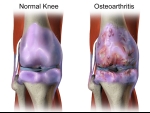Home »
Blog » Pain Management
| Stem Cell, PRP, Acupuncture in Queens & Long Island, New York
Pain Management | Stem Cell, PRP, Acupuncture in Queens & Long Island, New York
Smooth knee movement can be affected by this condition. Please find out more about what it means and how to treat it. Knee movement is typically smooth, with the kneecap (patella) gliding within a V-shaped groove at the end of the thigh bone, called the trochlea. This stable movement allows you to stand, walk, and run without issues as the patella moves up and down as you bend and straighten your knee.
Read more
Golf caters to the senior player more than any other sport. There is no age limit, and the handicap system allows an ongoing and organized competition. A good thing, since the population is aging, with nearly twenty percent of Americans - or sixty million people - over the age of 65. Contrary to Mickey Mantle’s observation, “If I had known I was going to live so long, I would have taken better care of myself,” most people today are well nourished, more active, and generally committed to keeping their health in order.
Read more
Low Back Pain in Golfers: Causes and Prevention - Low back pain is a significant concern for many golfers during and after play. This common condition affects both athletes and non-athletes, impacting enjoyment and, in severe cases, leading to pain and disability. Understanding the causes of low back pain is crucial for prevention.
Read more
Osteoarthritis (OA) is a condition caused by the gradual wear and tear of joints over time. Multiple factors, including genetics, may increase your likelihood of developing this progressive disease. Osteoarthritis affects over 32.5 million adults in the United States and is the most common form of arthritis, particularly in older adults. It’s also a leading cause of disability. If OA runs in your family, you may be at a higher risk of developing it.
Read more
Knee osteoarthritis (OA) is a common condition that results in knee pain, inflammation, and stiffness. Various treatments are available, from heat and cold therapy, gentle exercises, and physical activity to medications and surgical interventions. Osteoarthritis affects the cartilage in joints and is the most common type of arthritis, impacting approximately 32.5 million people in the United States. The knee is particularly vulnerable to OA, making everyday tasks like walking, climbing stairs, and performing routine activities difficult.
Read more
Osteoarthritis can lead to joint pain and stiffness. Medications, lifestyle changes, and surgery may help reduce pain and inflammation. Osteoarthritis is a degenerative joint disease resulting in inflammation, stiffness, and pain. It’s the most common type of arthritis, affecting about 32.5 million people in the United States. As the disease progresses, osteoarthritis can limit mobility and decrease quality of life. However, treatment can slow its advancement.
Read more
A hernia is an abnormal protrusion (bulging) of tissue through a space where it doesn’t belong, often causing pain due to the trapped tissue. Common types of hernias include a herniated disk and the traditional "hernia" (in medical terms, an inguinal hernia). In a herniated disk, the tough outer layer (annulus fibrosus) of an intervertebral disk (the cushion between the bones in the spine) tears, allowing the jelly-like inner core (nucleus pulposus) to push through the tear.
Read more
No one wants to be sidelined with an injury. Ankle sprains and knee injuries, particularly ACL (anterior cruciate ligament) tears, are common in soccer. But is there anything you can do to reduce your chances of missing valuable playing time? Absolutely. Learning how to move with proper form and alignment is key to protecting your knees.
Read more
Soccer is a popular sport that can lead to various injuries, ranging from minor ankle sprains that may sideline players for a couple of weeks to more severe injuries like ankle fractures or ACL tears, which can take months to heal. The increasing popularity of highly competitive and physically demanding play, particularly among children and teenagers, has increased injury rates.
Read more
Understanding Back Pain in Pregnancy - Eighty percent of women will experience back pain at some point during their pregnancies. The severity can range from mild discomfort after standing for long periods to debilitating pain that disrupts daily life. Although back pain during pregnancy can sometimes indicate a more serious condition, such as the onset of labor, it is usually the result of natural bodily changes.
Read more
Love this Post? Spread the World
























